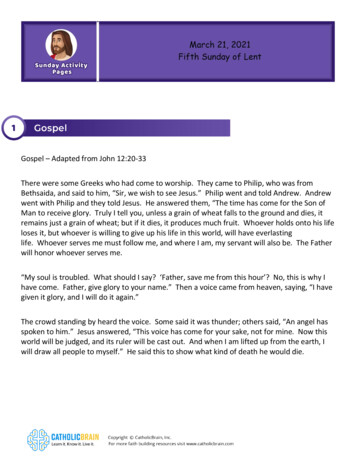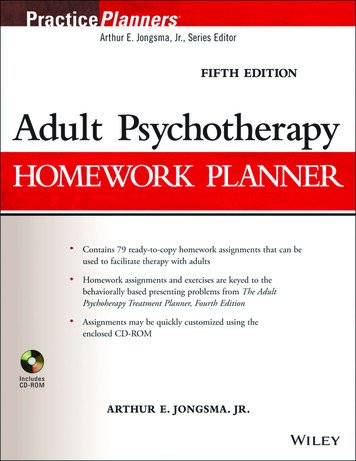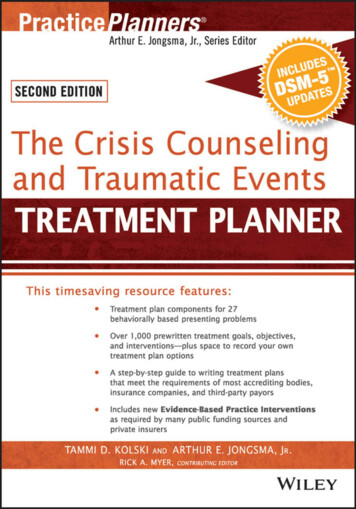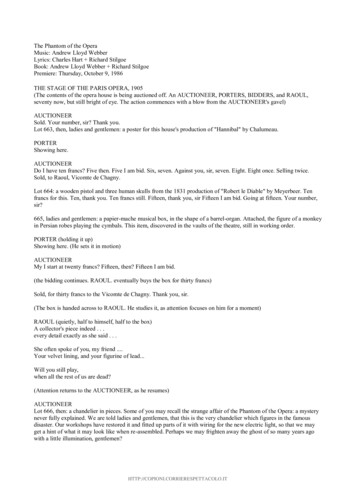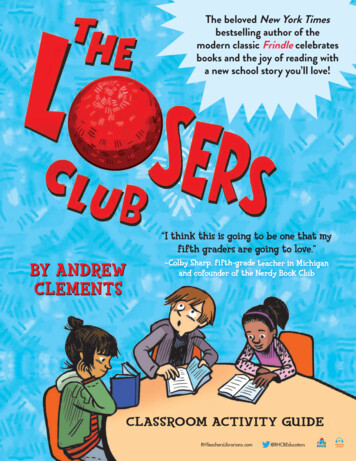
Transcription
The beloved New York Timesbestselling author of themodern classic Frindle celebratesbooks and the joy of reading witha new school story you’ll love!“I think this is going to be one that myfifth graders are going to love.”BY ANDREWCLEMENTS—Colby Sharp, fifth-grade teacher in Michiganand cofounder of the Nerdy Book ClubCLASSROOM ACTIVITY GUIDERHTeachersLibrarians.com@RHCBEducators
About the BookSixth grader Alec can’t put a good book down.Grades 3–7HC: 978-0-399-55755-2GLB: 978-0-399-55756-9EL: 978-0-399-55757-6CD: 978-1-5247-8243-6So when Principal Vance lays down the law—pay attention in class, orelse—Alec takes action. He can’t lose all his reading time, so he starts aclub. A club he intends to be the only member of. After all, reading isn’ta team sport, and no one would want to join something called the LosersClub, right? But as more and more kids find their way to Alec’s club—including his ex-friend turned bully and the girl Alec is maybe starting tolike—Alec notices something. Real life might be messier than his favoritebooks, but it’s just as interesting.With The Losers Club, Andrew Clements brings us a new school storythat’s a love letter to books and to reading and reminds us thatsometimes the best stories are the ones that happen off the page—our own!H “Clements’s latest is engaging and funny.ANDREW CLEMENTS is the New York Times bestsellingauthor of the beloved modern classic Frindle, which hassold over six million copies, won nineteen state awards (andwas nominated for thirty-eight!), and been translated intomore than a dozen languages. Called the “master of schoolstories” by Kirkus Reviews, Andrew is now the author of overeighty acclaimed books for kids. He lives in Maine with hiswife, Becky. They have four grown sons and two rascally cats.Visit Andrew online at andrewclements.com.Art 2017 by Laura ParkGeorge ClementeBook lovers and reluctant readers alike willenjoy the relatable characters, realistic dialogue,and humorous scenes.” —School Library Journal, Starred
Pre-Reading ActivitiesCharacter Trait Quick WriteThe main character, Alec, has a strong desire to always act honorably. Even when he is given anopportunity to speak poorly about someone who has mistreated him, Alec chooses to be kind. This isn’talways an easy choice to make. Encourage students to do a quick write about a time they witnessedsomeone act with integrity. Share these quick writes as well as students’ thoughts and ideas on how toreflect this important character trait. Tell students to be on the lookout for situations in the story thatexemplify Alec’s honorable choices or behavior.Roll-a-QuestionShare the questions and prompts below, and divide the class into pairs to start the conversations.Roll the die to find out which question or prompt you will respond to. Once you have given yourresponse, see what your partner thinks. Discuss why your answers are different or the same.1.The cover makesme think of . . .2.What are someclues the titlegives you aboutthe book?3.I predict . . .4.One questionI have beforeI begin readingis . . .5.Have you everfelt left out orthat it was hardto fit in? Whathappened?6.This storywill be about . . .During-Reading ActivitiesBuild a Bookordion“The Losers Club is actually a pretty good name. . . . We lose ourselves in books for hours and hours—books aboutall kinds of people and tons of different places. Then we come back, and we bring things with us.” (p. 224)Art 2017 by Laura ParkIn The Losers Club, Alec and the club members make an accordion of every book they’ve ever read. Havestudents build their own bookordion of books that they love, books that taught them an important lesson,or books they want to read. (You might put your own on your door to introduce your reading-self to kids.You could also encourage your class to make a bookordion of all the books they read over the courseof a semester or school year. Get other classrooms involved, and see which classroom has the longestbookordion!) They can draw or print out pictures of their book covers, and then tape them together togive inspiration to their classmates. See Andrew Clements’s very own bookordion below!
During-Reading ActivitiesCompare and ContrastMake a class set of copies of a Venn diagram. Students will work to compare themselves to one of themain characters. Here are some questions to help jumpstart their thinking: How are you and this character the same? Can you find physical descriptions of this character in the text? Do you look alike? What are this character’s hobbies? Which after-school club do they belong to? Do you have similarinterests? What are some personality traits that you would associate with this character? Are they brave?Kind? Outgoing? Shy? Boastful? Do any of these traits describe you?Be sure to use specific examples from the story for each notation that you make on the Venndiagram. See below for examples that could be added to the diagram and later used in a classdiscussion.SIMILARITIES:I have brown eyesand so does Nina. p. 39NINA:On p. 56,we find outNina has an olderbrother, Richie.On p. 56, Nina said to Kent,“What makes you thinkI would have joined thisclub if I had found out youwere in it?” Nina is beingsarcastic in the way she istalking to Kent. I amoften sarcastic with myclosest friends.ME:I don’thave anysiblings.Dear Diary . . .Ask students to choose one character, and reflect on the events that had the greatest impact on thatcharacter during The Losers Club. Students will then be asked to write three diary entries from theperspective of that character. Remind students that a diary should include thoughts, feelings, andspecific events from the story.Art 2017 by Laura ParkThe characters in this story experience a lot of ups and downs. Alec struggles with being teased byKent and with the challenges of starting a new after-school club. Alec also realizes he may like Nina—as a girl. This causes all sorts of confusion for him. The reader also sees Nina and Kent go throughtheir own ups and downs throughout the story.
Losers Club Comic StripIdentifying themes in a story is a higher-order skill that involves inferring and critical thinking. Hereare a few steps toward this goal:1) Properly Define Theme because it can sometimes be difficult to think beyond the elements andevents of a story.2) Prepare Students to Infer because the author will not tell readers what the theme is.3) Give Students Practice Identifying Themes from a variety of different texts, including The Losers Club.To prepare for the comic strip activity, divide the class into groups. Identify several possible themes ofThe Losers Club (friendship, courage, perseverance). Groups pick a theme and work together to createan eight-section comic strip with captions. The comic strip should depict a part of the story that theyfeel exemplifies their theme. Give students the opportunity to share their work upon completion. Youcould even make a class comic book!My Character’s PlaylistAssign student teams one character and give them time to reflect on that character’s storyline,considering all their ups and downs throughout The Losers Club. Groups are to think about thecharacter’s personality, motivations, hopes, and actions. Then use that information to help choose aminimum of three songs that they think this character would have in their personal playlist. Groupswill select songs that align with their character’s traits as well as the situations they go through inthe story. Songs should reflect any changes that may occur for the character, as well as importantevents and how their character responds to them. Use the below example of Brian (from Hatchet byGary Paulsen) as a model for citing evidence from both the song and the text to explain your playlistselections.Remind students to be sure to read the lyrics of each of their song selections to get a completeunderstanding of the song and its meaning.m HATCHET by Gary PaulsenOK: Brian froCHARACTER’S NAME AND BOl PlattenSONG: “Fight Song” by Raches heBrian finds a new strength and realizeals,trinymaerAft:CEENIDEVEXPLANATION WITHArt 2017 by Laura Parksurvive.must conquer his fears if he is going tot he could learnhope in his knowledge. Hope in the fact thaBute.gonwashat—tuedrescbeldwou“Not hope that he120)that night. I am full of tough hope.” (p.tughthohee,hopghTou.selfhimofeand survive and take carylist.’s “Fight Song” would be on Brian’s plattenPlalcheRatthankthimekesmaThislife song.“This is my fight song. Take back myned on.Prove I’m alright song . My power’s turStarting right now I’ll be strong.”
Post-Reading ActivitiesStart Your Own Losers Club!Alec was surprised to find out how many other kids loved reading and wanted to join his club. Witha few simple steps, you can start a Losers Club for your own class or as an after-school activity! Depending on your daily schedule, you can hold your Losers Club meetings after school or use theidea to facilitate literature circles in your classroom during reading time. Since we know there is a direct correlation between choice and intrinsic motivation, it is importantto let students select their own book-club books, just like in The Losers Club. Students can meet in acommon area such as the classroom or school library and enjoy the time to read silently with otherbookworms. A key to Alec’s success was his vast knowledge of books. With this, he was able to recommendspecific titles to friends like Kent and witness a peer falling in love with a book that they mightnot have otherwise chosen. To bring this special component into your book club, you can set asidetime at the end of each meeting for students to talk about what they like or don’t like about thebook. They can also recommend specific books for different friends as Alec does in the book. Thiswill foster conversation about different titles, genres, and authors among peers. It might also behelpful to have a librarian come in once a month to aid in the discussion.Personal ConnectionAsk students: Is there something in this story that has happened to you or someone you know?Using as many details as possible, students tell how their experience is the same as the character’sexperience in the story. They should describe what they learned and what the character learnedfrom this experience.A Hero’s JourneyThe Hero’s Journey is a cycle first explained in The Hero with a Thousand Faces by Joseph Campbell in1949. Watch the following TED Talk for more information about this ancient formula.youtube.com/watch?v Hhk4N9A0oCAIn The Losers Club, Alec is the story’s hero. Discuss the TED Talk about a hero’s journey, and see ifstudents can identify the different events on Alec’s path to becoming a hero.Art 2017 by Laura ParkThe narrator in the video uses a clock to help organize the hero’s cycle. The chart on the followingpage will allow students to do the same. Students write examples from The Losers Club that meetthe criteria for each hour or stage in the hero’s cycle. Remind students to include the page numberswhere the evidence can be found.Students can also use this chart to follow a hero’s journey in another favorite story, such as Hatchet,Island of the Blue Dolphins, or Number the Stars. Compare that hero’s journey to Alec’s journey.Alternatively, they can think of a time in their life when they had to act heroically, and use this chartto chronicle their personal journey.
A Hero’s JourneyBook Name: Hero’s Name:Stages of a Hero’s JourneyEvidence and Page NumberStatus QuoWhat is life like for this character at the beginningof their story? Are they happy? Are they wishingfor a change of some kind?12:00Call to AdventureSomething happens here that calls the character to atask. Is it an invitation? A challenge? A message?1:00AssistanceThe character can’t do it alone. Who will help them?2:00DepartureOur character leaves their ordinary life or situation(literally or figuratively) for a new life or adventure.3:00TrialsWhat are some of the obstacles this characterencounters?4:00ApproachThis is when the character has to face their biggestfear. What is it?5:00CrisisThis is typically a major problem—the most difficultso far—for our character and hero.6:00TreasureDoes the character gain something?7:00ResultWhat happened as a result of the Approach andCrisis? Did the character prevail?8:00ReturnThe character departs the situation or newworld and returns to their old world.9:00New LifeBack home, the character has a different perspectiveon things and has changed because of this journey.10:00ResolutionAll of the details become clear now, even for minorcharacters in the story.11:00New Status QuoThe character’s life has changed forever.12:00Art 2017 by Laura ParkStages of a Hero’s JourneyThe story opens with Alec sitting in the Hot Seat in Mrs.Vance’s office. He was in trouble, once again, for readingduring class and not paying attention. If Alec doesn’t changehis habits, he is going to be sent to summer school. (p. 7)Evidence and Page NumberReproducible
Share These Gems fromThe Losers Club Book ListMiddle GradeBud, Not BuddyChristopher PaulCurtisHolesLouis SacharWhen You Reach MeRebecca 1328-8The Book ThiefMarkus ZusakBrian’s HuntGary PaulsenBrian’s WinterGary PaulsenThe RiverGary 92958-7978-0-307-92961-7Under theBlood-Red SunGraham Salisbury978-0-385-38655-5Common Core Anchor Standards Addressed in This Educators’ GuideCCSS.ELA-LITERACY.CCRA.R.1: Read closely to determine what the text says explicitly and to make logical inferences from it; cite specific textual evidence whenwriting or speaking to support conclusions drawn from the text.CCSS.ELA-LITERACY.CCRA.R.2: Determine central ideas or themes of a text and analyze their development; summarize the key supporting details and ideas.CCSS.ELA-LITERACY.CCRA.R.5: Analyze the structure of texts, including how specific sentences, paragraphs, and larger portions of the text (e.g., a section,chapter, scene, or stanza) relate to each other and the whole.Prepared by Erica Rand Silverman and Sharon Kennedy (who would have loved to have been in a Losers Club), former English teachers and cofoundersof Room 228 Educational Consulting, along with educator Kelly Hoover rm228.comArt 2017 by Laura ParkYoung Adult
To prepare for the comic strip activity, divide the class into groups. Identify several possible themes of The Losers Club (friendship, courage, perseverance). Groups pick a theme and work together to create an eight-section comic strip with captions. The comic strip should depict a part of the story that they feel exemplifies their theme.

